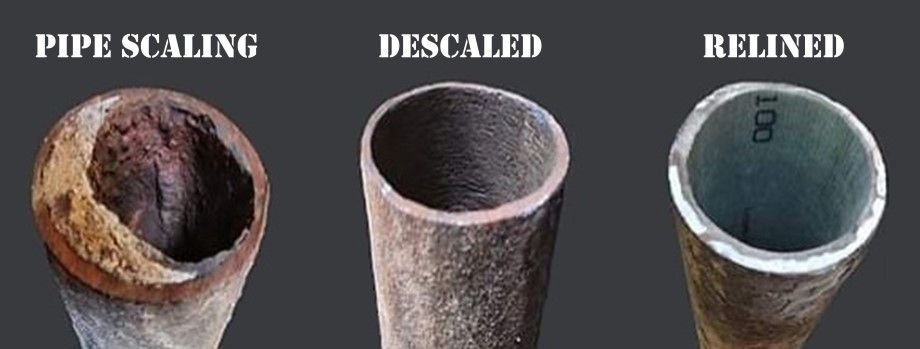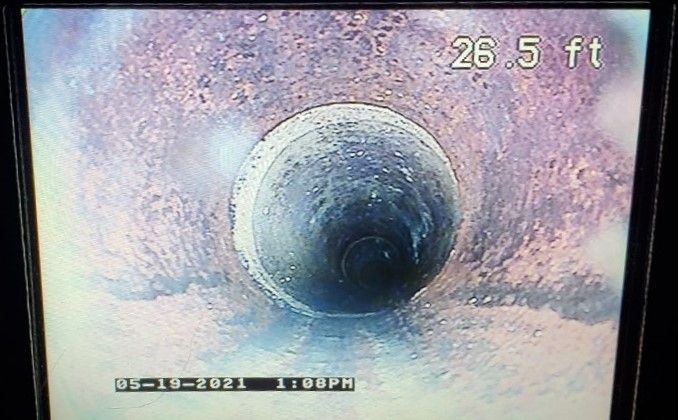Descaling Sewer Line

Pipe scaling is a term that refers to the build-up of minerals and rust in the inner linings of a sewer line. Calcium carbonate and magnesium are some of the most common minerals that build up. Allowing the scaling to build up will decrease the amount of water that can flow through your sewer.
Pipe descaling is the removal of accumulated minerals and rust from the inner surfaces of sewer lines. It is an important and necessary sewer cleaning procedure in places where the water supply is full of minerals like calcium or magnesium carbonates.
Cast iron pipes tend to have more severe scaling because their inner surfaces become coated with iron oxide as well as calcium and magnesium salts. When a sewer line develops a thick, uneven layer of mineral and rust deposits, it begins to snag any solids and grime that flow past the rough sections. Eventually, the sewer line becomes clogged or blocked. Luckily, descaling is a good way to clear sewer lines and restore them to working condition.
How Sewer Line descaling is done
There are two main methods used to do pipe descaling. The first is by scrubbing the pipes with abrasive mechanical tools. The second is hydro jetting. How a technician chooses to descale a sewer line depends on the extent of the blockage and scale buildup in the sewer line. The length of the sewer line is also a factor. After a technician does a thorough inspection of the sewer line, they will recommend the most effective descaling technique. Technicians often use the following methods to remove scale buildup from sewers:
Hydro Jetting and Descaling of Sewer Line
The technician will choose this method to clear a sewer line that is heavily clogged. First, they will blast a jet of highly pressurized water (water with a force of at least 3,500 pounds per square inch) to remove any blockage. Next, the technician will attach a descaling nozzle to the hydro-jet, which will blast pressurized water through the nozzle. The descaling nozzle has a chain attached to it, much like a chainsaw. When pressurized water flows through the nozzle, it rotates the chain, which scrubs the rust and mineral buildup from the pipe’s surface. The descaling nozzle scrubs the pipe and washes away the debris at the same time.
Mechanical Descaling of Sewer Line
A technician may choose to remove scaling with the use of mechanical tools. They will choose this method if the pipe is relatively clear of other blockages and less than 75 feet long.
The technician will scrub the sewer line using a mechanical tool to clear the calcium and magnesium salts as well as the rust from the pipe. If the build-up is heavy, they may need to hydrojet the pipe after.
 Video Camera Inspection of Descaled Sewer Line
Video Camera Inspection of Descaled Sewer LineWhy descaling is good for sewer lines
Modern descaling methods are a non-invasive way of cleaning sewer lines, which means that a property owner gets to avoid the inconvenience and cost of dug-up yards, concrete floors, and smashed walls. Descaling also improves drainage and water flow while increasing the lifespan of the sewer system. It is also a convenient repair method because the occupants of a building can continue to use the facilities even as a plumber works on the sewer. If you are dealing with constantly backed-up drains, it is time to call a professional. Chances are that they will find scaling in your pipes.
Ready to get started?
Get in touch with us if you need to get your sewer line working as if it were put in yesterday. To schedule pipe descaling service and learn more, call General Rooter LLC at 763-634-2564 for the Minneapolis & St Paul Metro area or call General Rooter of Southern MN at 507-550-2564 for pipe descaling in Southern Minnesota.
